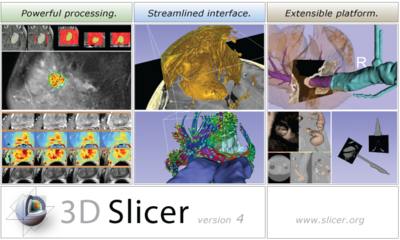|
|
| (141 intermediate revisions by 16 users not shown) |
| Line 1: |
Line 1: |
| − | Unearthing Your Hidden [http://www.xa-seo.cn SEO] Guru
| + | __NOTOC__ |
| − | How many of these actions have you conducted in a professional capacity for your company or a client?
| + | |
| − | * Posted a video to YouTube with a few tags and a remotely descriptive title.
| + | [[Image:NIHlogo.png|100px]][[Image:NIHHHS-logo.png|60px]] |
| − | * Rated your company’s video on YouTube (or related video sites from Google, Yahoo, or MSN).
| + | |
| − | * Submitted a press release to some online newswire (or a traditional newswire that also posts releases online).
| + | These wiki pages are used to curate meetings and events of interest to developers and users of open source software for medical image computing. |
| − | * Tagged photos on Flickr (owned by Yahoo).
| + | |
| − | * Posted an event to Upcoming.org (owned by Yahoo).
| + | NA-MIC was founded as a multi-institutional, interdisciplinary team of computer scientists, software engineers, and medical investigators to develop computational tools for the analysis and visualization of medical image data. It was funded from 2004-2015 using a grant, U54 EB005149, from the NIBIB NIH HHS. NA-MIC created infrastructure and environment for the development of computational algorithms and open-source technologies, and created training and dissemination mechanisms for these tools to be distributed to the medical research community. |
| − | * Added a local listing to Google Base.
| + | |
| − | Okay, maybe you haven’t done any of this, but if you serve in a marketing role, you probably will before long, and all of these actions can provide greater exposure for your Web presence in the major engines. That’s because of the impact of universal search (the term Google gave it) or blended search, which refers to how the engines pull in content from a range of other sources (including the engines’ own databases) into the main body of natural search results. Another version of this is modular search, pioneered by Ask.com, where the different types of content (images, video, local listings, etc) each appear in a separate field beside the main body of natural listings. (Thanks go to colleague Chris Humber, my in-house [http://www.xa-seo.cn SEO] guru, for shedding light on the nuances).
| + | '''While NA-MIC itself is no longer a funded research effort, many research projects driven by NA-MIC technologies continue.''' |
| − | The twist here is that if universal, blended, or modular search becomes the long-term standard rather than an engine fad (another personal guru, colleague Eric Richmond, noted that it’s too soon to determine users’ preferences), it’s likely that there will be a much larger group of people contributing to a site’s search visibility than ever before.
| + | |
| − | The concept itself isn’t totally new. Press release optimization, local search optimization, and social media optimization have been bandied about for years, to name just a few of the subdisciplines. Yet universal search allows all those “___ ___ optimization” specialties to come together. It’s all search engine optimization, and it includes a retail store manager updating a local business listing, an events manager posting a public function, a marketing assistant publishing clips on a video site, a marketing director ghost-writing a C-level executive’s entry on a corporate blog, and everyone in the company who participates in any way — rating the business or YouTube clip, adding the blog to an engines’ feed aggregator, RSVPing to an event, or taking some other action. All these actions can signal that the content is relevant and helps it rank higher in natural search results.
| + | {| |
| − | That doesn’t create less work for the true [http://www.xa-seo.cn SEO] masters. While everyone in an organization can make a small positive impact, it’s also likely that most people will have no sense of how their actions contribute to [http://www.xa-seo.cn SEO] and thus impact a company’s sales and brand. That means much of the optimization potential will be wasted. These professional SEO experts must then emerge not just as technologists but as evangelists, educators, and shepherds.
| + | |[[Image:Slicer4Announcement-HiRes.png|400px|align:"top"]] |
| − | As for the congregants, pupils, and flocks, you’re now ready to enter your never-ending [http://www.xa-seo.cn SEO] training. It’s one more way you’ll be able to contribute to the future success of your business.
| + | |- |
| | + | | |
| | + | Please visit the [[Events]] page to learn about meetings that to take place to continue biomedical research seeded by NA-MIC. |
| | + | |
| | + | |- |
| | + | |Slicer 4.10 released in November 2018. See the [https://www.slicer.org/wiki/Documentation/4.10/Announcements Announcement] for more information. |
| | + | |} |


These wiki pages are used to curate meetings and events of interest to developers and users of open source software for medical image computing.
NA-MIC was founded as a multi-institutional, interdisciplinary team of computer scientists, software engineers, and medical investigators to develop computational tools for the analysis and visualization of medical image data. It was funded from 2004-2015 using a grant, U54 EB005149, from the NIBIB NIH HHS. NA-MIC created infrastructure and environment for the development of computational algorithms and open-source technologies, and created training and dissemination mechanisms for these tools to be distributed to the medical research community.
While NA-MIC itself is no longer a funded research effort, many research projects driven by NA-MIC technologies continue.

|
|
Please visit the Events page to learn about meetings that to take place to continue biomedical research seeded by NA-MIC.
|
| Slicer 4.10 released in November 2018. See the Announcement for more information.
|


